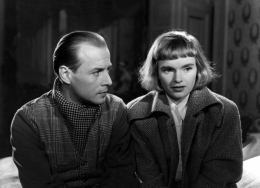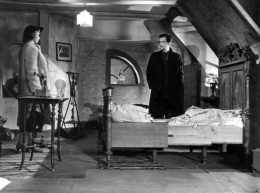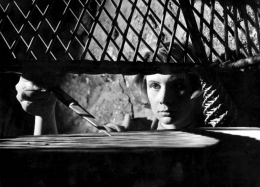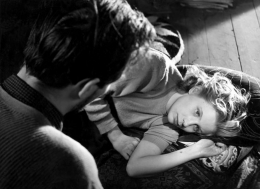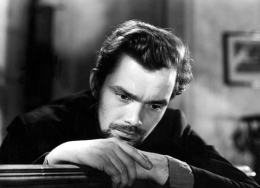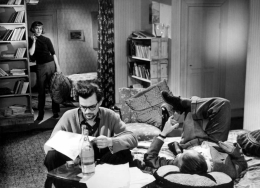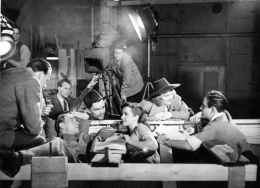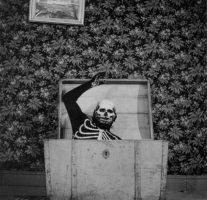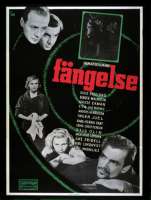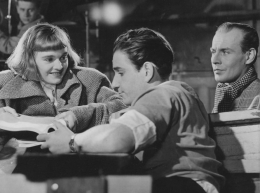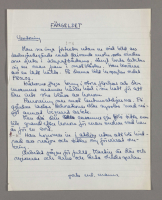Prison
Innovative drama about a misanthropic screenwriter feauturing prostitution and child murder.
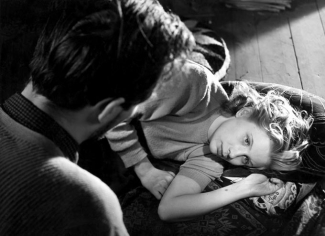
"For the first time in 25 years Sweden is once again at the developmental cutting edge of world cinema."Robin Hood in Stockholms-Tidningen
About the film
Prison was the first film Ingmar Bergman directed from his own, entirely original, screenplay. He was given this exciting opportunity by Terrafilm's Lorens Marmstedt on condition that he would try to keep production costs down as far as possible. The initial budget was set at 185,000 Swedish kronor, compared to the standard budget of the day of more than 300,000 kronor. Yet costs rose to 240,000 kronor, mostly because of unforeseen extra footage that proved necessary. In newspaper interviews, however, Marmstedt professed himself satisfied. Making a feature for less than 240,000 kronor was a major achievement in itself.
Bergman in Images: My Life in Film:
Harbour City opened in October 1948 and was a relative success. At About the same time Ellen, my wife then, and I went to the summer cottage in Dalecarlia where I spent my childhood. There I wrote the sceenplay for The Devil´s Wanton (Prison) [...]
During the previous summer I had written the story of Birgitta Carolina as a long short story with the title 'True Story', alluding to a very popular genre in weekly magazines at the time that was called 'true stories from life'. I wanted my story to be that way: with inhibited swings between unabashed sentimentality and genuine feelings. I was extreamly pleased with the title of the film, finding it suitably ironic. But my producer Lorens Marmstedt, who knew everything there was to know about Swedish movie audiences, said that people didn't understand irony; they'd just get mad as hell. He asked me to find another title. First I came up with The Prison and then simply Prison, which was typical for the 1940s and, actually, a much worse title than True Story.
I hesitated when I handed the sceenplay to Lorens Marmstedt and said something like, 'You don't have to bother with this. But if you have the time and inclination at some point, take a look at it'. I did not even give Svensk Filmindustri a chance to consider it, fully realizing that it would be futile. Two days later Lorens called me and said in his roundabout way, 'Very touching...I don't know...perhaps...after all. Touching but not moving! One can't tell. Possibly? How fast can you work?'. 'Eighteen days. Not less than eighteen days'. I said. Then we disscused actors, and he called around and told each one, 'Don't count on getting your regular salary because this is an artistic film and one has to sacrifice something for Art!' I myself did not receive a penny, just 10 percent of the profit. There never was any profit!
Sources of inspiration
In an article in Stockholms-Tidningen the day before the première, Ingmar Bergman himself wrote about the financial constraints of the production:
Make a cheap film, make the cheapest film ever made in a Swedish studio and you'll be given enormous freedom to work entirely as your conscience and invention dictate. For this reason I set out to cut down on costs right across the board. The plan took shape as follows: Reduce the number of studio days. Limit set building. No extras. No music, or a minimal amount. Ban overtime. Limited access to celluloid. Exterior shots without lighting or sound. All rehearsals to be conducted outside the shooting period. Start early in the mornings. Make sure that all filming of unnecessary material is prevented. Meticulous pruning of the screenplay. [...]
Obviously, not all films can be made on such a minimal budget. But nonetheless I have a feeling that the external arrangements are often over estimated, and that the organisation and technical execution of a film shoot could be more cleverly and practically effected in Swedish films.
Looking inward, Hitchcock has made an important contribution in terms of revolutionising the technology of filmmaking, working in a more purposeful and compact way. I myself believe that what he has achieved in this area will gradually be appreciated by people on the technical side of films, and that they will rank him with those pioneers among whom he justly belongs.
Working in this way he has just completed a film called Rope (banned by the censors in Sweden and decried in America, but it might be good anyway), which is the concentrated result of long and patient technical experimentation. (For anyone interested, this can be followed from film to film.) The process hardly sounds remarkable in itself: He uses long scenes. But: he uses long scenes which nobody notices are especially long.
As everyone knows a film is made up of between three and five hundred fragments which are glued together to make one long strip (the film itself). Hitchcock currently does not use three hundred fragments, more like ten, eleven or fifteen. Yet these require a completely new and different approach to planning a film shoot, synchronisation and an agreement between director, cinematographer, set designer and sound engineer which passeth all understanding. What one needs to achieve is a meticulous coordination between the movements of the camera and the actors on the one side, and the suitability of the scenography on the other.
With an arrangement like this, the director wins a good deal of time (time is money in the studio), continuity and concentration. He loses certain opportunities to cut a tedious passage, shorten a pause or tinker with the rhythm. The editing takes place in the camera, and as one can grasp, the process is not to be recommended for the director who wants an easy life, actors who suffer from bad memories, or the cinematographer whose nerves are not the strongest. I have practised this Hitchcock technique as applicable. I believe the result has been successful. That is to say, one does not notice anything untoward.
Shooting the film
Shooting began on 16 November 1948 and came to an end on 4 March 1949. An important contribution was made by actor and fellow director Hasse Ekman, who had previously taken a hand in Bergman's adaptation of A Ship to India.
Bergman in Images: My Life in Film:
Prison was well cast. In that area, Lorens Marmstedt was generous and invaluable. He convinced Hasse Ekman, who was important and busy, to participate as well as Ekman's wife at the time, Eva Henning, who had just enjoyed great success in Ekman's The Banquet. Hasse Ekman was unswervingly loyal and helpful. Eva Henning brought a totally unexpected tone of pure sorrow to the film. She has a brief scene with the director in which she says, 'Is it so that we as children collect something that called-spirit?' Eva Henning does the scene absolutely beautifully with her austerity, her warmth, and her sense of humor. Doris Svedlund as Birgitta Carolina was also lovely. It was important to me that she not look like the typical Swedish movie whore. Prison is, after all, a story about a soul, and she is the soul. Doris shone with her own enigmatic light.
The farce that Thomas and Birgitta Carolina present in the little toy projector in the attic is one that I made up as a child. It is about a man who is locked up in a mystical room where all kinds of atrocities happen to him: A spider descends from the ceiling; a villain appears with a long knife ready to kill him; the devil jumps out of a chest; and Death, a skull, jiggles in front of a window with wide-slatted blinds. we filmed the farce quickly and efficiently. The acting trio in it consisted of three Italians, The Brothers Bragazzi. They had performed at the China Variety Theater and had remained in Sweden for the duration of the war.
They arrived at the studio early in the morning. We picked out some clothing from Sandrew's costume department. Göran Strindberg set up four open lamps with straight light and installed grease-proof paper so there wouldn't be any shadows. I told the story, and the Bragazzi began playing like children. We filmed all of it before lunch. The material was sent to the lab immediatly. The next morning it was developed and copied. Then Lennart Wallén and I put the little farce together in the editing room of Terrafilm, whereupon we summoned Lorens Marmstedt and held our world premiere. Lorens laughed till he cried. Then he treated us to champagne.
Epilogue
The fact that the prostitute in the film, Birgitta Carolina, had a job at the well-known EPA department store, caused some annoyance among the staff of the actual shop. As one of the union representatives put it in Dagens Nyheter: "We have exactly the same salaries as equivalent staff working for other employers, so we do not need to walk the streets to support ourselves." The manager of the store also expressed his views, and shortly thereafter the film's director felt obliged to enter the fray, which he did in the same newspaper three days later:
By way of reply to the charges that have been levelled by EPA against my film Prison, I would like to stress that I do not regard the female shop assistants at EPA as streetwalkers, any more than I regard the male employees of Sweden's postal service as pimps, those who work in Systemet (the Swedish state liquor store chain) as child murderers, contemporary writers as alcoholics or mathematics teachers as mentally unhinged. Naturally, all the people and professions in my film are portrayed without any intentional counterpart in real life and are created from my imagination alone. I therefore see no reason to do anything other than continue to screen Prison in the uncut version first shown at the première.
Sources
- The Ingmar Bergman Archives.
- Ingmar Bergman, Images: My Life in Film.
- Ingmar Bergman, "På förekommen anledning", Dagens Nyheter, 5 April 1949.
- Leif Furhammar, Filmen i Sverige, (Dialogos, Stockholm 2003).
Lasse Bergström in Arbetaren:
It appears – to put it circumspectly – that with Prison, Ingmar Bergman has created the most distinctive Swedish film since Torment. Irrational, mould-breaking, full of feverish argumentation about life and constraint, laden with poetic overtones and glaringly wretched elements of doom, it may not be a faultless work of art, but the faults – here as in Torment – are hardly significant. The important thing is that Bergman, now that he has really been able to indulge in a cinematic experiment, has succeeded so remarkably well, and that Prison may actually become something of a landmark in Swedish cinema – since it has been relatively cheap to make. [...]
Robin Hood in Stockholms-Tidningen:
Prison is no ordinary film. It is the first time that Ingmar Bergman has made a film in his own right. His own idea, own screenplay, his own design, without the aid of experienced film people. And Prison is more Bergmanesque than any of his earlier films. Here he shows his true colours. It displays clear influences from the 1920s, yet also points from the 20s and 40s towards the future. A remarkable film. The new ways of feeling and seeing that belong to a new film generation have never hitherto been expressed with such consistency and power. No doubt to the great irritation of those conservatives who want the world, including the film world, to stand still, and no doubt to the inner delight of those who want it to move forward. For the first time in 25 years Sweden is once again at the developmental cutting edge of world cinema.
A Gunnar Bergman in Aftontidningen:
No, I am giving up all hope for Ingmar Bergman! If he continues to boil up the same old broth in this way, nobody in the end will believe there was ever anything of any worth in the bottom of the pot. Now he has produced a "morality play" for the cinema called Prison, but it does not contain one single ingredient not already present in the morality plays he has written for the theatre – Rachel and the Cinema Doorman, The Day Ends Early, Unto My Fear, Come Up Empty. The youthful thoughts about Life, God and the Devil which he has persistently concocted for the stage, have now been transplanted with equal determination – or shall we say obsession – into a film. And just as he has seduced a number of theatre directors for a while, he will now seduce a number of people in the film industry for a while. The latter always tend to jump on the bandwagon. But anyone who has followed his career from the outset, and seen or read everything he has produced, cannot avoid being gripped by tremendous desolation: the chap has an abnormally simple make-up, and he stopped developing the moment he discovered that a man and a woman get up to a good deal of mischief, and that living is not all neatness, sweetness and light, but is full of perils. [...]
On the other hand, Ingmar Bergman is a divinely gifted director both for stage and screen. And accordingly, this time round he has also made a film full of good ideas that breaks new ground in cinematic terms. If he had only had a story other than his own on which to hang his directorial talents the result would have been a shining example of originality, a breath of fresh air for the future! As it is, there is no balance between screenplay and direction – the former is banal, the latter not far short of brilliant.
C B-n in Dagens Nyheter
This is Ingmar Bergman the director at his very best, this drama of hopelessly abandoned young people among the toys of childhood, with music boxes from the past and a toy magic lantern that projects the most ridiculous of American horror farces from the time when the magic lantern was in its earliest infancy. At other times one is not so certain at all of the film's artistic value.
"Ingmar Bergman's new film, which he has both written and directed himself, will give rise to essays on film aesthetics. As a film it is different. And all this novelty dazzles the viewer, so that it takes a good hour before one realises that the screenplay is a piece of pretentious nonsense."
Nils Beyer in Morgontidningen
Distribution titles
El demonio nos gobierna (Argentina)
El demonio nos gobierna (Uruguay)
The Devil's Wanton (Great Britain)
The Devil's Wanton (USA)
Fængsel (Denmark)
Fängelse (Norway)
Gefängnis (West Germany)
Livets fengsel (Norway)
Prigione (Italy)
A prisão (Portugal)
Prisión (Spanien)
La prison (France)
Tiurma (Sovietunion)
Vankila (Finland)
Vezení (Czech Republic)
Wiezienie (Poland)
Production details
Production country: Sweden
Swedish distributor (35 mm): Terrafilm
Swedish distributor (DVD): Studio S Entertainment
Laboratory: Film-Labor
Production company: Terrafilms Produktions AB
Aspect ratio: 1,37:1
Colour system: Black and white
Sound system: AGA-Baltic
Original length (minutes): 78
Censorship: 075.006
Date: 1949-03-18
Age limit: 15 years and over
Length: 2160 metres
Release date:1949-03-19, Astoria, Stockholm, Sweden, 79 minutes
Filming locations
Sweden (1948-11-16-1949-03-04)
AB Sandrew-Ateljéerna, Stockholm
Old town, Stockholm
Music
Title: Drömmen
Composer: Erland von Koch (1949)
Comment: Instrumental.
Title: Blott en dag, ett ögonblick i sänder
Composer: Oscar Ahnfelt (1872)
Lyrics: Lina Sandell (1865)
Comment: Sung by unknown man.
Title: Vandringen
Composer: Erland von Koch (1949)
Comment: Instrumental.
Title: Vart ska du gå?
Composer:: Alice Tegnér
Comment: Sung by girl (from a record, Musica E19015 - 1942).
James Quandt, 1996:
Bergman's first major work, Prison makes a strong case for the proclamation that opens it: "Human life is an inferno." Gunnar Fischer's hard-edged expressionist cinematography is ideally suited to the harsh subject matter. A young author whose marriage has driven him to the brink of either murder or suicide is prompted by a film director to visualize his relationship with a prostitute. In an old attic, the "lovers" attempt to recapture their childhood. She falls asleep and, in a series of encounters that weave dream, nightmare, and "reality," she is confronted with his sadistic cruelty.
The scenes of torture (involving cigarettes) and suicide were so extreme that Swedish censors trimmed the film. The imagery of death masks, dolls, and butchered animals is brilliant preparation for Bergman's later excursions into the world of dreams, and the film-within-a-film device looks forward to Persona.
Collaborators
- Doris Svedlund
- Birger Malmsten
- Eva Henning
- Hasse Ekman
- Stig Olin
- Irma Christenson
- Anders Henrikson
- Marianne Löfgren
- Birgit Lindkvist
- Curt Masreliez
- Anita Blom
- Arne Ragneborn
- Kenne Fant
- Inger Juel
- Torsten Lilliecrona
- Segol Mann
- Börje Mellvig
- Åke Engfeldt
- Gösta Ericsson
- Åke Fridell
- Lasse Sarri
- Britta Brunius
- Gunila Klosterborg
- Ulf Palme
- Sven Björling
- Inga Lindeström
- Chris Poijes
- Karl Öhman
- Harry "Snilleblixten" Karlsson
- John W. Björling
- Britta Holmberg
- P.A. Lundgren, Art Director
- Bengt Westfelt, First Assistant Cameraman
- Göran Strindberg, Director of Photography
- Gösta Petersson, Unit Manager
- Lennart Wallén, Film Editor
- Olle Jakobsson, Production Mixer
- Erland von Koch, Music Composer
- K.J. "Jocke" Fredriksson, Key Grip
- Gunnar Jónsson, Key Grip
- Lorens Marmstedt, Producer
- Allan Ekelund, Production Manager / Production Coordinator
- Kalle "Rubank" Karlsson, Carpenter
- Harry Jakobsson, Other Crew
- Erik Jerkö, Other Crew
- Ingmar Bergman, Screenplay
- P A Lundgren
